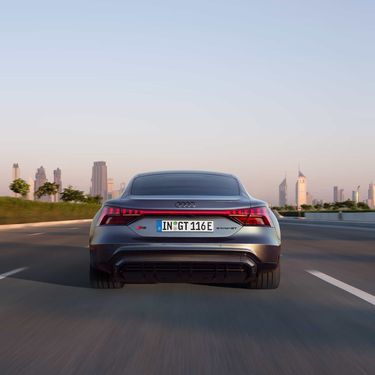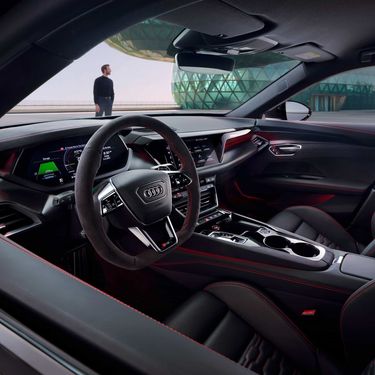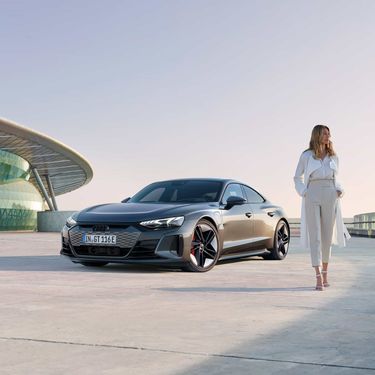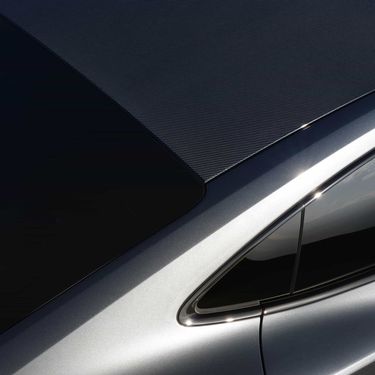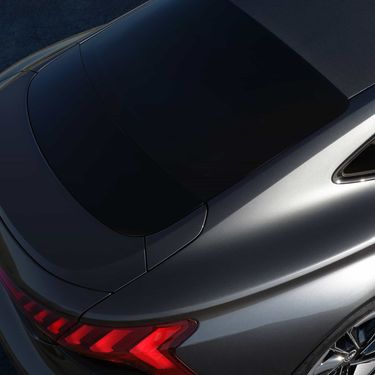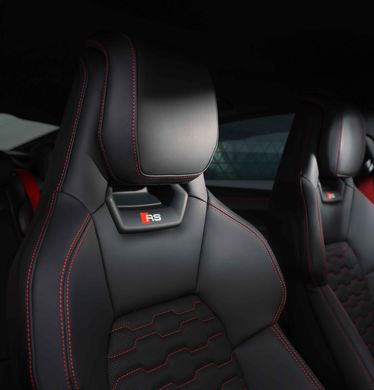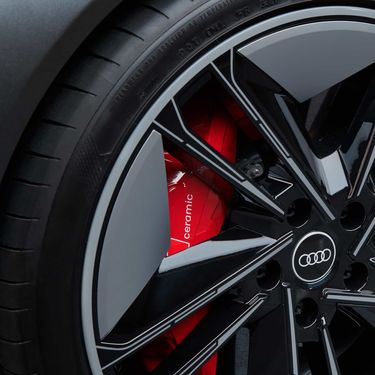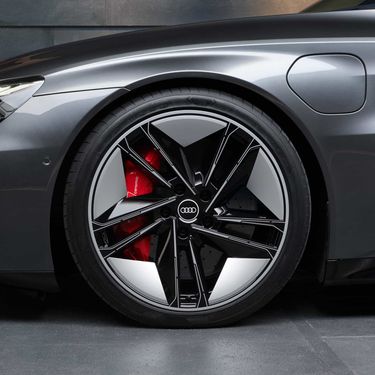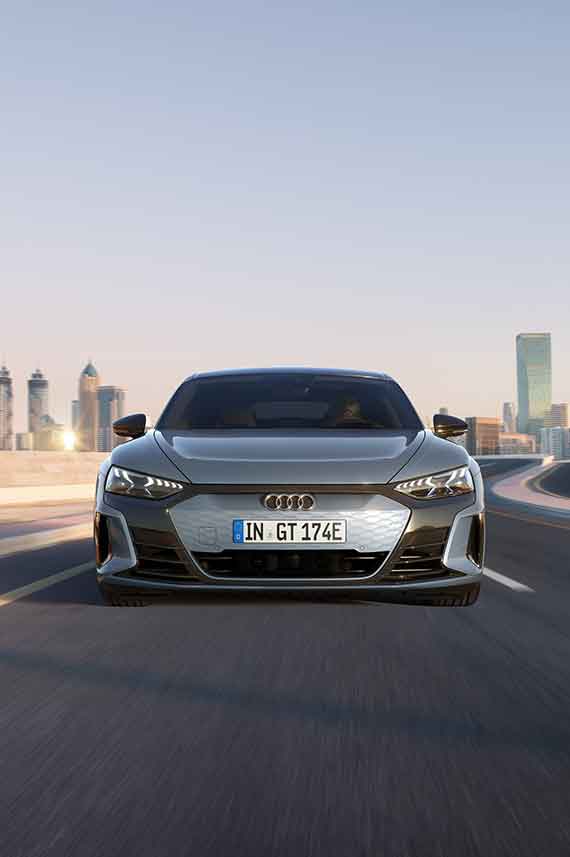Audi RS e-tron GT: the emotional electric coupé | Audi.de
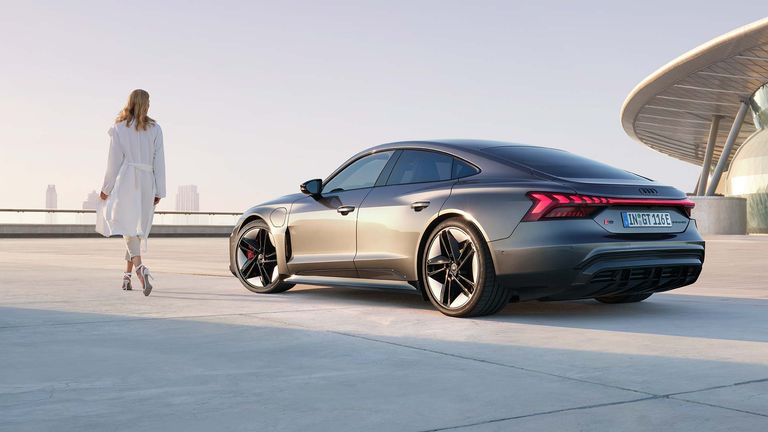
RS e-tron GT
CO₂ emissions combined¹: 0 g/km (WLTP)
Power consumption combined¹: 22.1–19.8 l/100 km (WLTP)
Maximum electrical power up to
440
kW¹
Total electrical torque: 830 Nm
Acceleration (0-100 km/h) up to
3.3
s¹
Range (WLTP) up to
495
km¹
Electric. Among other wonderful things
Quick configurator
Combine different paint finishes and wheels and experience the Audi RS e-tron GT² in the interactive 3D view.
Exterior design
The ambition – to reinterpret a car – is also reflected in the purist design, which is inspired by aerodynamic performance. Progressive luxury provides the impetus to further intensify a driving experience brimming with emotion. Characteristic: RS emblems with the Red Rhombus.
The RS design package, grey⁹ also underscores the pronounced elegance and the progressive design of the vehicle interior through a combination of high-quality interior materials and contrasting stitching in steel grey.
Audi exclusive⁵
Become a designer yourself and create a look for your Audi RS e-tron GT² so that it is as unique as your own character.
Creating uniqueness
Combine various options and experience the diversity and customization possibilities of Audi exclusive⁵, for example with the Audi RS e-tron GT². For a particularly interactive experience, activate the 3D view by clicking on the 3D button.
Audi RS e-tron GT
Change Interior Base Color
Change Interior Contrast Color
Change Interior Stitching Color
Change custom paint
Charged from 5% to 80% in approx.
22.5
min¹
(at maximum DC charging power of up to 270 kW and under ideal conditions⁶)
Charging system
800
volt¹
Maximum charging power up to 270 kW
Battery capacity (net) up to
83.7
kWh¹
Combined power consumption¹ in kWh/100 km: 22.1–19.8; Combined CO₂ emissions¹ in g/km: 0. Only consumption and emission values according to WLTP and not according to NEDC are available for the vehicle.
Charging at home and on the road
The 800-volt lithium-ion battery integrated flat into the underbody offers extremely high performance – both when charging and when driving. In conjunction with the recuperation system, a range of up to 472 km was calculated according to the WLTP measuring procedure (Power consumption combined¹: 22.1–19.8 l/100 km (WLTP); CO₂ emissions combined¹: 0 g/km (WLTP). Only consumption and emission values according to WLTP and not according to NEDC are available for the vehicle).
Driving dynamics
The power that the Audi RS e-tron GT² offers with the fully electric quattro all-wheel drive is impressive. A motor on the front axle and one at the rear deliver up to 440 kW of power (Power consumption combined¹: 22.1–19.8 l/100 km (WLTP); CO₂ emissions combined¹: 0 g/km (WLTP). Only consumption and emission values according to WLTP and not according to NEDC are available for the vehicle).
1
This catalogue was developed for the sole purpose of informing customers and consumers of the specifications, components and other existing accessories of AUDI brand vehicles marketed within the European Union, content that may be modified at any time and without prior notice by AUDI without incurring any liability.
In accordance with the foregoing, AUDI does not guarantee the availability of the vehicle model referred to in this catalogue with all the specifications and components indicated herein, since these may vary or be limited depending on your location.
Under no circumstance will AUDI be liable to customers, consumers and/or any third party for the non-existence, unavailability or modification of the models contained in this catalogue, being the obligation of the customer, consumer and/or any third party to verify the availability of the model prior to its acquisition depending on their location.
In accordance with the foregoing, AUDI does not guarantee the availability of the vehicle model referred to in this catalogue with all the specifications and components indicated herein, since these may vary or be limited depending on your location.
Under no circumstance will AUDI be liable to customers, consumers and/or any third party for the non-existence, unavailability or modification of the models contained in this catalogue, being the obligation of the customer, consumer and/or any third party to verify the availability of the model prior to its acquisition depending on their location.
2
RS e-tron GT: Combined power consumption¹ in kWh/100 km: 22.1–19.8; Combined CO₂ emissions¹ in g/km: 0. Information on fuel/power consumption and CO₂ emissions with ranges depending on the selected equipment of the vehicle. Only consumption and emission values according to WLTP and not according to NEDC are available for the vehicle.
3
Due to physical constraints, the maximum output for the acceleration figures given can be repeated multiple but not an unlimited number of times in a row.
4
Audi exclusive is an option available for an extra charge from Audi Sport GmbH. Please contact your Audi partner or visit www.audi.com for detailed information about standard and optional equipment.
5
The charging time of the battery can vary depending on a number of factors including ambient temperature, the use of other country-specific connectors and use of the preconditioning function (e.g. remote-controlled air conditioning of the vehicle). When using domestic connectors, the e-tron charging system limits charging capacity.
6
For AC charging, Audi recommends charging the high-voltage battery at industrial power sockets, at charging stations or at a wall box. This is more efficient and considerably quicker than charging at a domestic power socket. The vehicle should not be regularly charged at domestic power sockets using the mobile e-tron charging system (compact and connect) if there is access to an industrial power socket with alternating current (AC) or a public AC or DC charging station. Charging capacity depends on the type of mains connector used, the country’s voltage and the number of available phases of the power network as well as the customer’s own domestic installation. It may therefore be lower in some cases.
7
The equipment mentioned is an option available for an extra charge.
8
Depending on country-specific availability.
